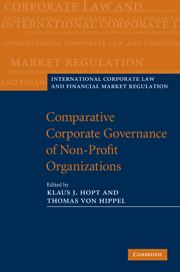Book contents
- Frontmatter
- Contents
- List of contributors
- Preface
- Abbreviations
- PART I Economic findings and theories on nonprofit organizations
- PART II The nonprofit sector: private law, trust law, tax law in selected countries
- PART III The board of nonprofit organizations
- 8 The board of nonprofit organizations: law and practice
- 8.1 The board of nonprofit organizations: puzzling through the gaps between law and practice – a view from the United States
- 8.2 The board of nonprofit organizations: some corporate governance thoughts from Europe
- 9 The duty of obedience
- PART IV Good governance of nonprofit organizations: activities and regulatory problems
- PART V Good governance of nonprofit organizations: self-regulation, disclosure and supervision
- Index
- References
8.1 - The board of nonprofit organizations: puzzling through the gaps between law and practice – a view from the United States
from 8 - The board of nonprofit organizations: law and practice
Published online by Cambridge University Press: 05 August 2011
- Frontmatter
- Contents
- List of contributors
- Preface
- Abbreviations
- PART I Economic findings and theories on nonprofit organizations
- PART II The nonprofit sector: private law, trust law, tax law in selected countries
- PART III The board of nonprofit organizations
- 8 The board of nonprofit organizations: law and practice
- 8.1 The board of nonprofit organizations: puzzling through the gaps between law and practice – a view from the United States
- 8.2 The board of nonprofit organizations: some corporate governance thoughts from Europe
- 9 The duty of obedience
- PART IV Good governance of nonprofit organizations: activities and regulatory problems
- PART V Good governance of nonprofit organizations: self-regulation, disclosure and supervision
- Index
- References
Summary
Introduction
Scholars of American corporate governance – both for-profit and nonprofit – have long remarked on the contrast between the sketchiness of the legal regime and the robust and diverse set of practices inside boardrooms and executive suites. To many, this state of affairs is the desired result of a laissez-faire legal structure that sets forth minimum rules of the road but that otherwise provides only default rules for conduct. Indeed, the Delaware supreme court – speaking for the state in which most large US corporations are incorporated – recently observed: “All good corporate governance practices include compliance with statutory law and case law establishing fiduciary duties. But the law of corporate fiduciary duties and remedies for violation of those duties are distinct from the aspirational goals of ideal corporate governance practices…”
This laissez-faire legal construct makes sense for corporations that have private owners. Minimal laws put a lower bound on behavior to prevent opportunistic behavior, but otherwise get out of the way. Where corporate statutes set forth rules of practice, they can, in most cases, be overridden by the corporate charter or bylaws. After all, the theory goes, owners do not need to be protected from themselves and the contracts they might enter into. To contractarian purists, fiduciary duties in the business context impose only a duty of loyalty and good faith, and do not expose fiduciaries to monetary liability for breaches of the duty of care waived by the shareholders unless there is lack of good faith.
- Type
- Chapter
- Information
- Comparative Corporate Governance of Non-Profit Organizations , pp. 481 - 530Publisher: Cambridge University PressPrint publication year: 2010
References
- 3
- Cited by



